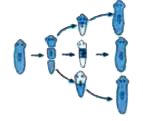Why are budding, fragmentation and regeneration all considered as asexual types of reproduction ? With neat diagrams explain the process of regeneration in Planaria.
Text Solution
Budding, fragmentation and regeneration are all asexual modes of reproduction. These are modes that involve only one parent which gives rise to next progeny.There is no fusion of gametes/cells to give rise to the next generation. Hence, the progeny thus produced is genetically similar to the parent generation. It is for these reasons that these are types of asexual reproduction.
If Planaria is cut into many pieces, each piece is capable of developing into a complete organism. This is known as regeneration Regeneration is carried out by specialised cells. These cells proliferate and make large numbers of cells. From this mass of cells, different cells undergo changes to become various cell types and tissues. These changes take place in an organised sequence referred to as development.

|
Topper's Solved these Questions
- HOW DO ORGANISMS REPRODUCE ?Book:U-LIKE SERIESChapter:HOW DO ORGANISMS REPRODUCE ?Exercise:SHORT ANSWER QUESTIONS
Explore 69 Videos
- HEREDITY AND EVOLUTIONBook:U-LIKE SERIESChapter:HEREDITY AND EVOLUTIONExercise:LONG ANSWER QUESTIONS
Explore 18 Videos
- LIFE PROCESSESBook:U-LIKE SERIESChapter:LIFE PROCESSESExercise:Long answer questions
Explore 22 Videos
Similar Questions
Knowledge Check
Assertion (A): Budding, fragmentation and regeneration are all considered as asexual types of reproduction.
Reason (R) : They involve only one parent.ABoth (A) and (R) are true and (R) is correct explanation of the assertionBBoth (A) and (R) are true but (R) is not the correct explanation of the assertionC(A) is true but (R) is false.D(A) is false but (R) is true.Which type of regeneration in found in planaria?
AMorphallaxisBEpimorphosisCCompensatoryDBoth 1 & 2
Explain regeneration in Planaria.
View SolutionWhy are framentation , spore formation, fission and budding considered asexual reproduction ?
View SolutionExplain the terms fission and regeneration as used in relation to reproduction
View SolutionExplain the term regeneration as used in relation to reproduction.
View Solution(a) What is fragmentation in organisms? Name a multicellular organism which reproduces by this method.
(b) What is regeneration in organisms? Describe regeneration in Planaria with the help of a suitable diagram.
View SolutionTypes OF Asexual Reproduction In Animals 1) Fission 2) Budding 3) Fragmentation 4) Regeneration
View Solution
